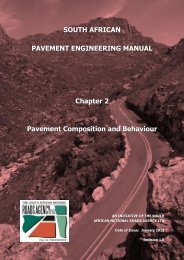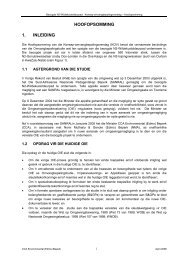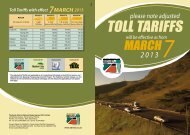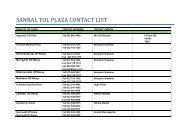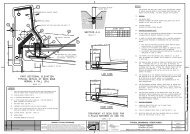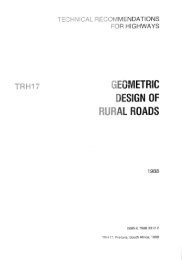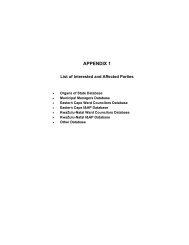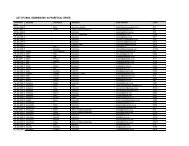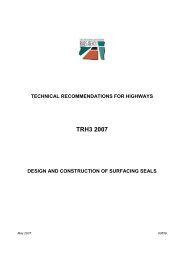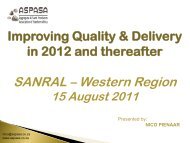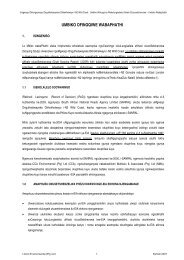CHAPTER 7 - STEEL REINFORCEMENT
CHAPTER 7 - STEEL REINFORCEMENT
CHAPTER 7 - STEEL REINFORCEMENT
You also want an ePaper? Increase the reach of your titles
YUMPU automatically turns print PDFs into web optimized ePapers that Google loves.
The minimum radii of bends are:<br />
• High Tensile Steel = 3 Bar diameters<br />
• Mild Steel = 2 Bar diameters<br />
7.3.4 Placing and Fixing<br />
Placing and fixing of reinforcement into the forms for the structure is one of the most important<br />
aspects of the construction of a structure. Special care should be taken by the monitoring staff to<br />
ensure that the reinforcement is placed and fixed in accordance with the design by verifying the<br />
following:<br />
(a) Type of steel (R or Y)<br />
(b) Diameter of bar<br />
(c) Bar mark<br />
(d) Spacing of bars<br />
(e) Concrete cover (refer to item 7.3.5 below)<br />
(f) Laps as per drawing (refer to designer if in doubt)<br />
(g) Grouping of bars to create space for placing and vibrating concrete.<br />
(h) All reinforcement should be adequately tied together and properly supported to ensure that<br />
the reinforcement does not displace and move in position during the concreting process as<br />
this will affect the cover to bars and the effective functioning of the concrete member.<br />
(i) Adequacy of stools and clips provided (need for stools where not provided).<br />
(j) Where bars are detailed to project out of a member (such as parapet anchors) they must be<br />
accurately placed and held in position.<br />
General neatness of the fixed reinforcement in the forms is<br />
always an indication of the accuracy of the placing and fixing<br />
and the contractor should be required to carry out corrective<br />
actions until the cages of reinforcement are fixed properly.<br />
7.3.5 Cover and Supports<br />
WARNING<br />
Do not allow the use of heating<br />
to bend reinforcement.<br />
WARNING<br />
Lack of cover on parapet<br />
anchors/starter bars results in<br />
loss of durability, pop outs and<br />
corrosion of reinforcement<br />
The minimum cover requirements are usually given on the drawings and/or in the project<br />
specifications.<br />
When checking the placing and fixing of reinforcement the monitoring staff must pay special attention<br />
to ensure that the specified cover to reinforcement is achieved. Cover has the most significant effect<br />
on the long term durability of reinforced concrete and therefore of the structure.<br />
Excess cover should be avoided as micro cracking due to bending stress can result in the growth and<br />
development of cracks and resulting corrosion of reinforcement or member loss due to spalling. The<br />
correct cover is required to ensure that reinforced concrete members meet their specified design<br />
requirements.<br />
Steel Reinforcement 7-3




